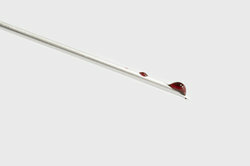Where is hemoglobin formed?
Hemoglobin is made in the bone marrow. But what do you actually need the dye for? Is it just a question of aesthetics?

Hemoglobin is a mixture of proteins and pigments
- Most people probably know hemoglobin by its abbreviation Hb and the connection "Hb value". It is determined with a blood test and is understood by laypeople as the "iron value". But it's not that simple.
- Hemoglobin is a protein-dye compound (three parts protein, one part dye) in the blood; it makes up about a third of the total mass of erythrocytes. The dye contains bivalent iron, an important pillar of the oxygen and carbon dioxide transport within the respiration.
- The protein-dye compound can loosely bind oxygen to itself and also easily release it again, so the iron-containing dye is, so to speak, the oxygen carrier of the blood. If the red blood cells are broken down in the liver, the hemoglobin is the starting product of the bile pigment.
The substance is formed in the bone marrow
- Hemoglobin is made in the bone marrow. Iron is released during the breakdown; this is also used in parallel with the renewed formation of the protein-dye compound. The total amount of hemoglobin in the body of an adult is about 650 grams, about 57 grams are produced daily in the bone marrow.
- A healthy adult has between 120 and 180 g of hemoglobin in the blood; the normal range for men is between 140 and 180 g, for women between 120 and 180 g. This corresponds to an Hb value of 14-18 g / dl or 12-16 g / dl.
If the Hb value is too low, there is anemia, which is not infrequently accidental within ...
- The determination of the Hb value is part of routine diagnostics in medicine because it can be used to estimate the oxygen transport capacity of the blood and thus provide indications Diseases that require treatment and have a very negative impact on quality of life, for example various forms of anemia (anemia) or polyglobulia (increase in Erythrocytes in the blood).
How helpful do you find this article?
The content of the pages of www.helpster.de was created with the greatest care and to the best of our knowledge and belief. However, no guarantee can be given for the correctness and completeness. For this reason, any liability for possible damage in connection with the use of the information offered is excluded. Information and articles must under no circumstances be viewed as a substitute for professional advice and / or treatment by trained and recognized doctors. The content of www.helpster.de cannot and must not be used to make independent diagnoses or to start treatments.

